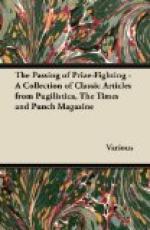Saloons, they “most do congregate.”
Once set your eyes upon them, once become acquainted
with their habits and manners, and then mistake them
if you can. They are themselves, alone:
like the London dustmen, the Nemarket jockeys, the
peripatetic venders, or buyers of “old clo’,”
or the Albert continuations at one pound one,
they appear to be made to measure for the same.
We must now describe them (to speak theatrically)
with decorations, scenes, and properties! The
entirely new dresses of a theatre are like the habiliments
of the professional singer, i.e. neither one
nor the other ever were entirely new, and never
will be allowed to grow entirely old. The double-milled
Saxony of these worthies is generally very
blue or very brown; the cut whereof sets a
man of a contemplative turn of mind wondering at what
precise date those tails were worn, and vainly speculating
on the probabilities of their being fearfully indigestible,
as that alone could to long have kept them from Time’s
remorseless maw. The collars are always velvet,
and always greasy. There is a slight ostentation
manifested in the seams, the stitches whereof are
so apparent as to induce the beholders to believe
they must have been the handiwork of some cherished
friend, whose labours ought not to be entombed beneath
the superstructure. The buttons!—oh,
for a pen of steam to write upon those buttons!
They, indeed, are the aristocracy—the yellow
turbans, the sun, moon, and stars of the woollen system!
They have nothing in common with the coat—they
are on it, and that’s all—they
have no further communion—they decline
the button-holes, and eschew all right to labour for
their living—they announce themselves as
“the last new fashion”—they
sparkle for a week, retire to their silver paper,
make way for the new comers, and, years after, like
the Sleeping Beauty, rush to life in all their pristine
splendour, and find (save in the treble-gilt aodication
and their own accession) the coat, the immortal coat,
unchanged! The waistcoat is of a material known
only to themselves—a sort of nightmare illusion
of velvet, covered with a slight tracery of refined
mortar, curiously picked out and guarded with a nondescript
collection of the very greenest green pellets of hyson-bloom
gunpowder tea. The buttons (things of use in this
garment) describe the figure and proportions of a
large turbot. They consist of two rows (leaving
imagination to fill up a lapse of the absent), commencing,
to all appearance, at the small of the back,
and reaching down even to the hem of the garment,
which is invariably a double-breasted one, made upon
the good old dining-out principle of leaving plenty
of room in the victualling department. To complete
the catalogue of raiment, the untalkaboutables have
so little right to the name of drab, that it would
cause a controversy on the point. Perhaps nothing
in life can more exquisitely illustrate the Desdemona




